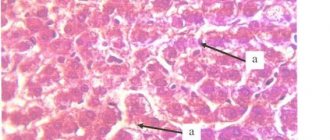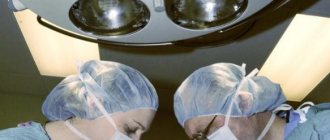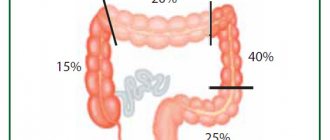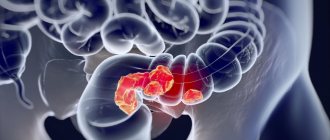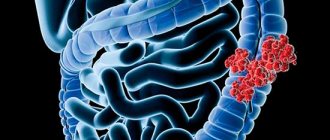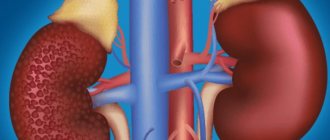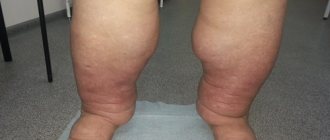Lactase deficiency (LD) in newborns is a pathological condition in which the child’s body contains a small amount of lactase. The enzyme does not break down incoming milk, which adversely affects the well-being of the newborn, its growth and development. Since lactose is not digested in the baby's body, he does not receive the necessary nutrition in full. A preliminary diagnosis can be made based on the external manifestations of the disease, taking into account the complaints of the child’s parents. Lactase deficiency, recommendations for eliminating which can only be given by a pediatrician, is a correctable condition.
What is lactase deficiency, its types
Lactose is a sugar found in the milk of mammals. The component has a beneficial effect on the growth and development of the child, increases his energy, stimulates the digestion process, and helps maintain normal intestinal microflora. Lactase is a substance that breaks down lactose. The enzyme is contained in the human body from the first days of his life. An insufficient amount of this substance in a child’s body makes lactose a favorable environment for the reproduction and growth of pathogenic microflora.
Depending on the origin of the pathological condition, LI is divided into congenital and acquired types. Type 1 deficiency is caused by the genetic characteristics of the child's body, and occurs in cases where the parents or close relatives of the baby also have lactase deficiency. The second type of disorder is acquired; it occurs in pediatrics more often than the first.
There is also a special, transient form of lactase deficiency. Its specificity is that the baby cannot tolerate mother's milk only at certain periods of time. This type of FN is most often observed in premature, low birth weight infants.
Diagnostics
To confidently diagnose lactase deficiency, it is not enough for a doctor to evaluate the symptoms and general appearance of the child. Laboratory confirmation is required. First of all, “diet diagnostics” is recommended. The method is based on excluding foods that contain milk or its derivatives from the baby’s diet. In the absence of milk sugar - lactose - in the diet of a child presumably suffering from LI, the symptoms will completely disappear or become significantly less pronounced. Biochemical examination of stool is of great importance. With FN, there is a decrease in stool pH (less than 5.5), in some cases the appearance of lactose or carbohydrates in the stool. The “gold standard” for diagnosis is taking biopsies from the intestines and determining lactase activity in them. However, the method is complex and requires invasive intervention in the body, so its use in pediatrics is significantly limited. If lactase deficiency is primary, it can be diagnosed using genetic testing.
Features of lactase deficiency in infants, its causes
Congenital LI develops due to the prematurity of the child. His intestines are not ready to ensure complete digestion, and the lactase content in the body is insignificant.
The reason for the development of acquired LI is the particular state of the body of the baby or woman during gestation. In both cases, we are talking about factors that caused damage to the cells that produce lactase, which caused a deficiency of this enzyme. This happens when:
- The mother suffered from an intestinal infection while pregnant.
- A newborn has an allergic reaction to cow's milk protein.
- The baby suffered from an intestinal infection.
- The mother of the newborn has chronic diseases of the digestive system.
- A newborn developed atrophic changes in the intestine caused by a long period of tube feeding.
- The baby developed colitis (inflammation of the large intestine).
- The child was diagnosed with a severely progressive helminthic infestation.
- During pregnancy, the woman was treated with hormonal drugs.
There is also such a reason for the development of LN as lactose intolerance, caused by improper organization of breastfeeding of the baby. Sometimes the baby only drinks lactose-fortified foremilk. It enters the intestines in large volumes, and due to age, and not disease, the child’s body does not digest lactose (due to insufficient lactase). Therefore, it is important that the newborn consumes not only front, but also hind breast milk. This will contribute to proper digestion, growth and development of the baby, strengthening its immunity, and improving overall well-being.
Symptoms of lactose intolerance in adults
If there is not enough lactase in the small intestine, then lactose is sent to the body in broken down form. As a result, within 20-30 minutes after consuming dairy products a person may have:
- bloating,
- diarrhea,
- pain in the intestines,
- nausea,
- rumbling,
- weakness,
- dizziness.
This is how lactose intolerance manifests itself in adults. This disease is also called “lactase deficiency” (LD).
How to recognize lactase deficiency in a baby?
The disease is confirmed only if the results of laboratory and instrumental studies are available. These include a biopsy of the small intestine and stool examination. An examination of the baby and a survey of his parents are necessary to study the medical history, establish a preliminary diagnosis, and exclude the presence of pathologies that are similar in symptoms.
Lactase deficiency can manifest itself with the same symptoms as intestinal infection, classic dysbiosis, colitis, enteritis.
Biopsy is a dangerous, time-consuming method: experts prefer to prescribe it in cases of extreme necessity. Therefore, doctors recommend only laboratory tests to determine how much of the enzyme is contained in the child’s body. The results of the coprogram and stool analysis for carbohydrates together allow us to understand the reason for the deterioration of the newborn’s well-being.
Important! The child's stool should be submitted for examination in the first hours after bowel movement.
However, using excrement from a diaper is not recommended. It is optimal for the baby to defecate on oilcloth. Before taking material for research, you should stop using laxatives. The newborn should have bowel movements naturally.
Symptoms
Lactase deficiency is manifested mainly by negative symptoms from the gastrointestinal tract. Noted:
- increased gas formation (flatulence), which may be accompanied by abdominal pain, bloating, and clearly audible gurgling;
- diarrhea - loose stools, which are additionally distinguished by a sour odor and bubbling consistency (in the secondary form of FN, the stool may be greenish in color and may contain particles of mucus);
- constipation is a rare but possible alternative to diarrhea;
- Children do not gain weight, and with severe LI, rapid weight loss may even be observed.
All symptoms appear after the child drinks milk or after a short period of time after eating dairy foods. Lactase deficiency may also be accompanied by allergy symptoms, irritability, moodiness, sleep disturbances, and a lag in physical or mental development from age-related norms. Doctors also note that children suffering from lactase deficiency are more likely to have vitamin D deficiency, seizures, attention deficit disorder and other similar diseases.
Symptoms and signs of lactase deficiency in infants
Symptoms of lactase deficiency in infants can be observed by all attentive parents - the main signs are:
- Newborn behavior. During feeding, he is restless, shows increased activity, tearfulness, and does not respond for a long time to attempts to calm him down.
- Change in the nature of bowel movements. The consistency is liquid, with a sharp, sour odor, and there is a frequent urge to defecate.
- Intestinal peristalsis. During feeding, the baby can hear rumbling in the tummy, which is associated with increased gas formation.
- Intestinal colic. Due to metabolic disorders and disruption of the digestive process, the newborn experiences intra-abdominal discomfort. Intestinal colic begins to bother the child after 30 minutes. after finishing feeding. It is during this period that the process of digestion and breakdown of lactose begins. The child tenses up, cries loudly and for a long time, and actively raises his legs.
- Appearance. A newborn is pale, lethargic, apathetic, and does not correspond to his age.
Indirect signs of LI are the appearance of rashes on the skin of the baby’s face and body. Since the iron content depends on the concentration of lactase in the body, the child may develop anemia, which cannot be eliminated with medications or improving the quality of nutrition.
Other signs of lactase deficiency in infants are a sharp alternation of increased appetite and a period of weakening, tearfulness, and frequent regurgitation. Since nutrition is not beneficial for the growth and development of the body, the child lags behind in physical development and is underweight. Due to the fact that milk is not digested, the baby experiences hunger: a few minutes after putting it to the breast, he loses interest in feeding and cries for a long time.
Prevention of lactase deficiency
To prevent this disease, it is necessary to prevent the symptoms of hypolactasia. This is done using a diet with a complete absence of lactose or low content. Therefore, if a patient experiences digestive disorders after eating unfermented dairy products, it is necessary to conduct a genetic test for lactase activity: it will allow you to choose a suitable diet and avoid attempts at pointless treatment. Using this test, you can also predict lactose intolerance in children in order to avoid unexpected intestinal disorders.
Diet of a nursing mother
A mother's diet for lactose intolerance in infants involves limiting or completely abstaining from drinking whole milk. In this case, the daily diet should contain a fermented milk product, hard cheese or butter, since they serve as a source of calcium and vitamins. A woman should exclude cow's milk from her diet, since the protein it contains can be irritating to the child's body. If after this correction the child no longer shows signs of intestinal irritation, it means that the condition was not caused by lactase deficiency, but by an allergy to protein.
A woman who is lactating must exclude foods and dishes containing sugar from the menu. Optimal nutrition - vegetables, rice, eggs, nuts, corn, lean meats and fish.
How to replace products with lactose?
Lactose is found in all dairy products, plus some confectionery products, instant foods, meat, tablets, and dietary supplements. Pay attention to the ingredients.
For people intolerant, lactose-free or plant-based milk is suitable. Or fermented milk products, in which lactose has already been broken down by lactic acid bacteria, so kefir, yogurt, fermented baked milk, as well as butter and cheese do not give an uncomfortable effect.
Lactase enzyme is sold in tablets or capsules. You can drink it before drinking milk. This method should not be used without consulting a doctor.
Is it possible to cure and what to do if a baby has lactase deficiency?
If a child is diagnosed with lactase deficiency in the body, parents do not need to worry, because, regardless of the form of the pathology, it can be corrected. But for this it is important not to self-medicate, but to follow the recommendations of the observing pediatrician. Lactase preparations are used to treat children suffering from lactose intolerance. The most effective options are Lactase enzyme, Lactase baby, Lactazar. They are first dissolved in mother's milk and given to the baby.
Important! Lactase drugs do not affect the quality of a woman's milk.
To carry out 1 procedure, 30-50 ml of biological fluid is required. After mixing with the drug, the milk is infused for no more than 3 minutes. First, the newborn needs to be bottle-fed, and only then put to the breast. Lactase preparations are characterized by high therapeutic efficacy. They normalize the state of bowel movements already on the 4th day from the start of their use, intestinal colic is eliminated during the same period or a day later. After 10 days of proper use of the medication, the composition of stool improves.
If the newborn is bottle-fed, with LI he is transferred to low-lactose or lactose-free formulas. Additionally, symptomatic treatment is prescribed - probiotics are recommended, as they normalize the intestinal microflora. The child’s water-salt balance is also corrected. For children suffering from LI, it is necessary to select complementary foods especially carefully - they should not contain lactose.
Actions that will help overcome lactase deficiency:
1. Do not feed according to the schedule. In order for a newborn to consume not only foremilk, but also hindmilk, he needs to empty each mammary gland completely. To do this, you need to give the baby the breast at the initial appearance of his appetite, and not wait for specific feeding hours. Long intervals between feeding a newborn lead to the accumulation of foremilk in the breast, and the likelihood of access to hindmilk is reduced. 2. Do not neglect night feeding of the baby. At this time of day, large amounts of hindmilk are produced. 3. Follow a diet. The specialist will develop a nutrition program for the child regarding complementary foods (it should not be dairy). If the congenital form of LI is confirmed, the baby follows a diet for life. When lactase deficiency is caused by intestinal diseases, the child adheres to a therapeutic diet until the underlying pathology is eliminated. It is important to discontinue the diet gradually, and only after receiving the results of a control stool examination. Lactase deficiency is characterized by a favorable prognosis. A set of measures - the use of medications and maintenance therapy, a proper diet, a well-designed diet for the mother - contributes to the complete elimination of the disease.
Lactose and lactase: what happens to them in the human body?
If we ignore the true allergy to milk protein (most often cow's), then the vast majority of cases of poor milk tolerance are due to the so-called lactase deficiency. What kind of disease is this? Let's start from the very beginning.
In addition to fats and proteins, the milk of mammals (including humans) contains carbohydrates, primarily the milk sugar lactose. Lactose consists of two molecules of simple sugars - glucose and galactose, connected by a special bond. In order for lactose to be absorbed by humans, this bond must be broken. Only then can the resulting simple sugars glucose and galactose be easily absorbed in the small intestine.
The process of bond cleavage inside the lactose molecule is possible only in the presence of a special enzyme - lactase. The names are similar: the enzyme lactase breaks down the milk sugar lactose. This enzyme is located on the surface of the villi of the small intestine.
In humans and most mammals, the activity of the lactase enzyme is maximum after birth, this allows the absorption of large amounts of milk, which in the first months is the only source of food for the newborn. After stopping breastfeeding, lactase activity gradually fades as a person switches to an adult type of diet, where milk and dairy products are only a small part of the diet.
In some people, the decrease in the activity of this enzyme occurs very quickly, in others it is gradual, and a certain part of people maintain high lactase activity for a long time. What does this depend on?
It is known that the ability of lactase to break down the milk sugar lactose is regulated by a special gene. More precisely, two genes. One gene (LCT) encodes the enzyme lactase; without it, it simply could not be produced. The second gene located nearby is called MCM6, and its task is to regulate the activity of the LCT gene.
For example, it is known that the variant (genotype) of the MCM6 gene, designated C/C, is associated with low activity of the LCT gene, which leads to early lactose intolerance. With the T/T genotype, the activity of the LCT gene is high, even in adulthood. The C/T genotype is the most common variant and is most likely to develop lactose intolerance in middle age.
This information is very important because it is now possible to evaluate the MSM6 gene in laboratories.
So, the activity of the lactase enzyme is regulated by the gene; with age, the likelihood of a decrease in this activity increases. What happens to the milk sugar lactose if there is not enough enzyme to break it down in the small intestine? Some of the lactose will still be broken down and absorbed in the small intestine. The remaining undigested lactose molecules will move further through the small intestine and eventually reach the large intestine. During this process, due to high osmotic activity, lactose attracts water molecules, increasing the amount of fluid in the intestinal lumen, which increases the risk of developing diarrhea. Milk sugar that enters the colon is an excellent nutrient substrate for local bacteria, which actively begin to break it down, producing gases. Increased gas formation and bloating are common symptoms in such patients. In addition, people with impaired breakdown and absorption of lactose may experience mild abdominal pain, nausea and other unpleasant symptoms.
To summarize the above: low activity of the lactase enzyme leads to impaired absorption of lactose in the small intestine. lactase deficiency in medicine . Lactase deficiency, which occurs over time in adults, also has a second name - adult hypolactasia. This article will focus on this most common type of lactase deficiency. We will leave aside congenital lactase deficiency (an extremely rare disease of newborns) and secondary lactase deficiency (occurs as a consequence of a number of gastroenterological, infectious and other diseases).
